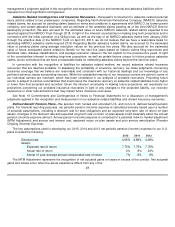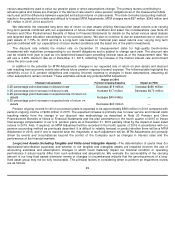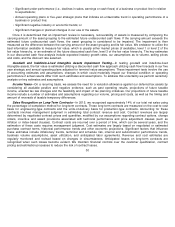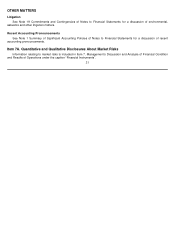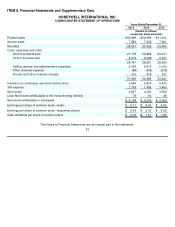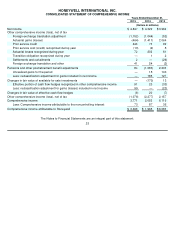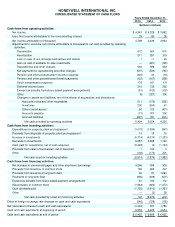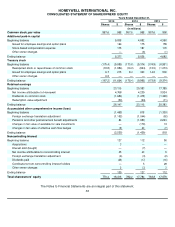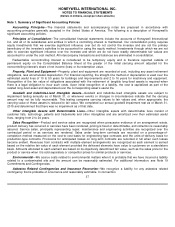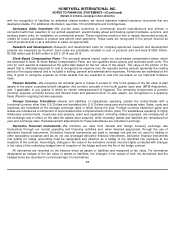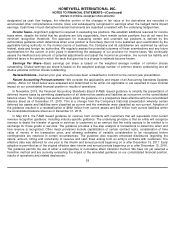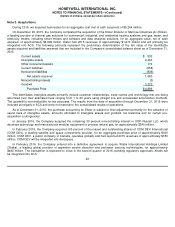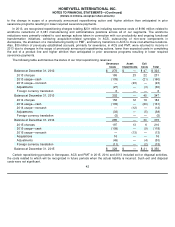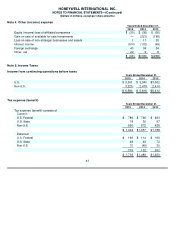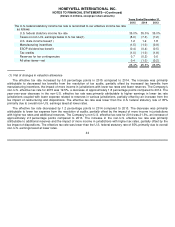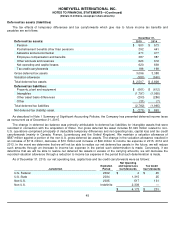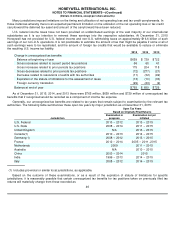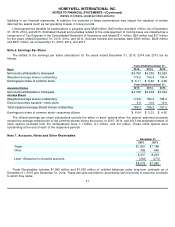Honeywell 2015 Annual Report Download - page 41
Download and view the complete annual report
Please find page 41 of the 2015 Honeywell annual report below. You can navigate through the pages in the report by either clicking on the pages listed below, or by using the keyword search tool below to find specific information within the annual report.
HONEYWELL INTERNATIONAL INC.
NOTES TO FINANCIAL STATEMENTS
(Dollars in millions, except per share amounts)
Note 1. Summary of Significant Accounting Policies
Accounting Principles—The financial statements and accompanying notes are prepared in accordance with
accounting principles generally accepted in the United States of America. The following is a description of Honeywell
’
s
significant accounting policies.
Principles of Consolidation—The consolidated financial statements include the accounts of Honeywell International
Inc. and all of its subsidiaries and entities in which a controlling interest is maintained. Our consolidation policy requires
equity investments that we exercise significant influence over but do not control the investee and are not the primary
beneficiary of the investee
’
s activities to be accounted for using the equity method. Investments through which we are not
able to exercise significant influence over the investee and which we do not have readily determinable fair values are
accounted for under the cost method. All intercompany transactions and balances are eliminated in consolidation.
Redeemable noncontrolling interest is considered to be temporary equity and is therefore reported outside of
permanent equity on the Consolidated Balance Sheet at the greater of the initial carrying amount adjusted for the
noncontrolling interest
’
s share of net income (loss) or its redemption value.
Property, Plant and Equipment—Property, plant and equipment are recorded at cost, including any asset retirement
obligations, less accumulated depreciation. For financial reporting, the straight-line method of depreciation is used over the
estimated useful lives of 10 to 50 years for buildings and improvements and 2 to 16 years for machinery and equipment.
Recognition of the fair value of obligations associated with the retirement of tangible long-lived assets is required when
there is a legal obligation to incur such costs. Upon initial recognition of a liability, the cost is capitalized as part of the
related long-lived asset and depreciated over the corresponding asset
’
s useful life.
Goodwill and Indefinite-Lived Intangible Assets—Goodwill and indefinite-lived intangible assets are subject to
impairment testing annually as of March 31, or whenever events or changes in circumstances indicate that the carrying
amount may not be fully recoverable. This testing compares carrying values to fair values and, when appropriate, the
carrying value of these assets is reduced to fair value. We completed our annual goodwill impairment test as of March 31,
2015 and determined that there was no impairment as of that date.
Other Intangible Assets with Determinable Lives—Other intangible assets with determinable lives consist of
customer lists, technology, patents and trademarks and other intangibles and are amortized over their estimated useful
lives, ranging from 2 to 24 years.
Sales Recognition—Product and service sales are recognized when persuasive evidence of an arrangement exists,
product delivery has occurred or services have been rendered, pricing is fixed or determinable, and collection is reasonably
assured. Service sales, principally representing repair, maintenance and engineering activities are recognized over the
contractual period or as services are rendered. Sales under long-term contracts are recorded on a percentage-of-
completion method measured on the cost-to-cost basis for engineering-type contracts and the units-of-delivery basis for
production-type contracts. Provisions for anticipated losses on long-term contracts are recorded in full when such losses
become evident. Revenues from contracts with multiple element arrangements are recognized as each element is earned
based on the relative fair value of each element provided the delivered elements have value to customers on a standalone
basis. Amounts allocated to each element are based on its objectively determined fair value, such as the sales price for the
product or service when it is sold separately or competitor prices for similar products or services.
Environmental—We accrue costs related to environmental matters when it is probable that we have incurred a liability
related to a contaminated site and the amount can be reasonably estimated. For additional information, see Note 19
Commitments and Contingencies.
Asbestos Related Contingencies and Insurance Recoveries—We recognize a liability for any asbestos related
contingency that is probable of occurrence and reasonably estimable. In connection
37


